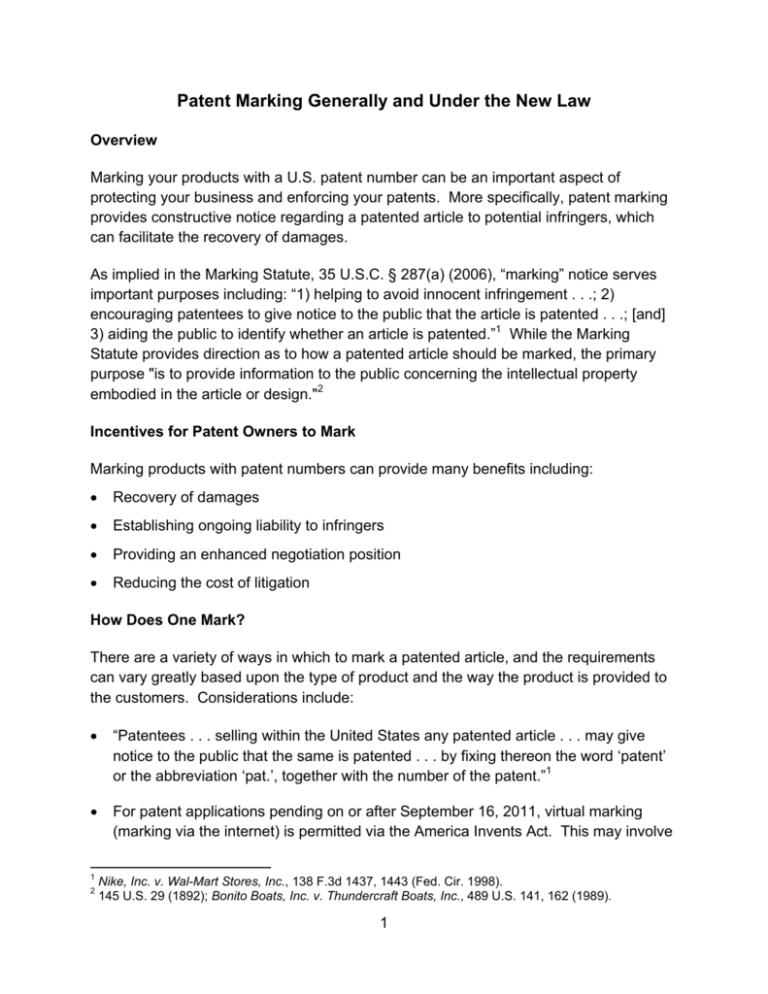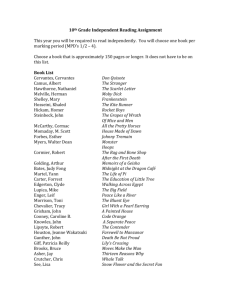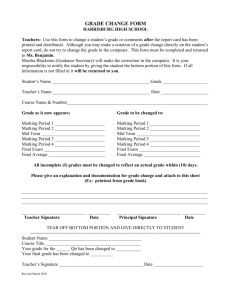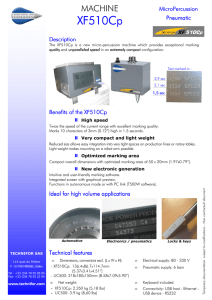
Patent Marking Generally and Under the New Law
Overview
Marking your products with a U.S. patent number can be an important aspect of
protecting your business and enforcing your patents. More specifically, patent marking
provides constructive notice regarding a patented article to potential infringers, which
can facilitate the recovery of damages.
As implied in the Marking Statute, 35 U.S.C. § 287(a) (2006), “marking” notice serves
important purposes including: “1) helping to avoid innocent infringement . . .; 2)
encouraging patentees to give notice to the public that the article is patented . . .; [and]
3) aiding the public to identify whether an article is patented.”1 While the Marking
Statute provides direction as to how a patented article should be marked, the primary
purpose "is to provide information to the public concerning the intellectual property
embodied in the article or design."2
Incentives for Patent Owners to Mark
Marking products with patent numbers can provide many benefits including:
Recovery of damages
Establishing ongoing liability to infringers
Providing an enhanced negotiation position
Reducing the cost of litigation
How Does One Mark?
There are a variety of ways in which to mark a patented article, and the requirements
can vary greatly based upon the type of product and the way the product is provided to
the customers. Considerations include:
“Patentees . . . selling within the United States any patented article . . . may give
notice to the public that the same is patented . . . by fixing thereon the word ‘patent’
or the abbreviation ‘pat.’, together with the number of the patent.”1
For patent applications pending on or after September 16, 2011, virtual marking
(marking via the internet) is permitted via the America Invents Act. This may involve
1
2
Nike, Inc. v. Wal-Mart Stores, Inc., 138 F.3d 1437, 1443 (Fed. Cir. 1998).
145 U.S. 29 (1892); Bonito Boats, Inc. v. Thundercraft Boats, Inc., 489 U.S. 141, 162 (1989).
1
marking the patented article with the word “patent” or the abbreviation “pat.” together
with an internet address that associates the patented article with the patent number.3
The patentee should review its patent portfolio and update product patent marking to
reflect all its patents covering the manufacture and use of the product, or that cover
the product itself.
Exceptions and Considerations
Various exceptions to the Marking Statutes may apply and nevertheless provide
constructive notice of a patent owner’s rights. Some exceptions include:
When an article cannot be marked, a label may be fixed to it or to the package in
which the article is contained.1 For instance, if a patent is directed solely to a
method or process, there may be no “article” available for marking.4
The marking of packaging may be sufficient where the patentee would have to bear
a significant burden to mark the product, such as adding a manufacturing step, and
where the cost of marking is commercially unreasonable.5
If a patent contains both method and apparatus claims but only the method claims
are asserted against an infringer in a lawsuit, the apparatus itself may not
necessarily have to be marked.6
If both apparatus and method claims are asserted and there is a tangible item to
mark, a court may require marking of the tangible, unless an exception applies.7
It may be sufficient to mark one piece of a multi-component product where all pieces
are included in the package delivered to the consumer.8
As an alternative to marking, written notice can be used to place potential infringers
on notice. Written notice has both pros and cons including, e.g., starting the
damages clock for willful infringement, and provoking the accused to file a
Declaratory Judgment Complaint. As such, care should be taken in taking steps
toward effecting written notice.
3
35 U.S.C. § 287(a)(2012) State Contr. & Eng’g Corp. v. Condotte Am., Inc., 346 F.3d 1057, 1073 (Fed. Cir. 2003).
5
Rutherford v. Trim-Tex, Inc., 803 F. Supp. 158, 164 (N.D. Ill. 1992) 6
See Hanson v. Alpine Valley Ski Area, Inc., 718 F.2d 1075, 1082-83 (Fed. Cir. 1983)(Reaffirmed in
Crown Packaging Technology, Inc. v. Rexam Beverage Can Co., 559 F.3d 1308,1316 (Fed. Cir. 2009)).
7
American Medical Systems, Inc. v. Medical Engineering Corp., 6 F.3d 1523 (Fed. Cir. 1993).
8
Douglas Press, Inc. v. Arrow Int’l, Inc., No. 95C3863, 1997 WL 441329 (N.D. Ill. July 30, 1997).
4
2
Closing Thoughts
Patent marking can be a helpful tool to establish constructive notice to potential
infringers. When used properly, marking can help protect your business and assist in
enforcement of your patents.
As the application of the Marking Statute, written notice and related law can vary
greatly, we encourage you to contact us for an evaluation specific to your needs.
For contact information and other informative articles, please visit us on the web at ipfirm.com.
© Crawford Maunu PLLC. All rights reserved. This material is for informational purposes only and should not be construed as legal
advice. Communication of this material is not intended to establish an attorney-client relationship. Legal advice should be sought
from legal counsel.
3







